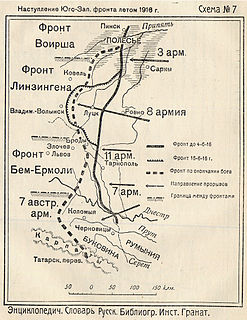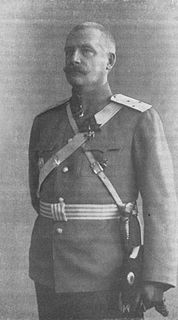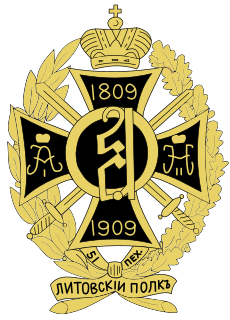Related Research Articles
The British Expeditionary Force (BEF) was the six-divisions the British Army sent to the Western Front during the First World War. Planning for a British Expeditionary Force began with the 1906–1912 Haldane reforms of the British Army carried out by the Secretary of State for War Richard Haldane following the Second Boer War (1899–1902).

The 21st Division was an infantry division of the British Army during World War I, raised in September 1914 by men volunteering for Lord Kitchener's New Armies. The division moved to France in September 1915 and served on the Western Front for the duration of the First World War.
The 1st Army was a field army-level command in the ground forces of Austria-Hungary during World War I. The army fought in Galicia and Russian Poland in 1914–15 before being briefly dissolved in the summer of 1916. Shortly afterwards, it was reformed and sent to fight in the Romanian Campaign for the next two years. The 1st Army was demobilized in April 1918 due to its heavy losses, following Romania's surrender.

The Russian Caucasus Army of World War I was the Russian field army that fought in the Caucasus Campaign and Persian Campaign of World War I. It was renowned for inflicting heavy casualties on the opposing forces of the Ottoman Empire, particularly at the Battle of Sarikamish. It was also known for its extremely diverse ethnic composition, consisting of units from throughout the Russian Empire and both soldiers and officers from the many ethnic communities settled since the 1877-78 Russo-Turkish War in the militarily administered Kars Oblast in the Russian Transcaucasus. These included Georgians, Caucasus Greeks, and Armenians - the latter in particular strongly represented among both the soldiers and senior officers - as well as ethnic Russians and Ukrainians.

The Allied leaders of World War I were the political and military figures that fought for or supported the Allied Powers during World War I.

The Russian Third Army was a World War I Russian field army that fought on the Eastern theatre of war.
The 3rd Army Corps was an Army corps in the Imperial Russian Army formed on 19 February 1877.
The Russian Sixth Army was a World War I Russian field army that fought on the Eastern theatre of war.

Vilna Military District was a military district of the Imperial Russian Army. The district was formed in 1862 as part of Russian military reforms and was responsible for parts of modern Belarus, Latvia, Lithuania, and Poland. The district was disbanded at the beginning of the First World War in July 1914, and its headquarters were used to form another district farther to the rear.
The 11th Army Corps was an Army corps in the Imperial Russian Army

Alexander Frantsevich Ragoza, in Ukrainian Oleksandr Frantsevych Rohoza, was a Minister of Defense of the Ukrainian State. He was also a general of the infantry in the Imperial Russian Army who saw service during World War I.

The 10th Army was a field army of the Imperial Russian Army during the First World War.

The Russian Eight Army was a World War I Russian field army that fought on the Eastern theatre of war.
The 3rd Army was a field army-level command within the ground forces of Austria-Hungary during World War I. It was primarily active on the Eastern Front against the Russian Empire and in the Balkans against Serbia and Montenegro. Later on, the 3rd Army took part in some fighting on the Italian Front before returning to the eastern theater by 1917 to repulse the Kerensky Offensive. Its remaining units were merged with the 7th Army in January 1918.
The 13th Army Corps was a corps of the Imperial Russian Army, formed in the 1870s. The corps fought in the Russo-Turkish War and World War I, and was disbanded with the collapse of the Imperial Russian Army after the Russian Revolution. During peacetime, it was stationed in the Moscow Military District.

Mikhail Alexandrovich Batorsky was a Red Army Komkor.
The 19th Army Corps was an Army corps in the Imperial Russian Army.

Vasily Yegorovich Flug was an Imperial Russian Army General of the Infantry. A career military officer, he served in the Boxer Rebellion, Russo-Japanese War, and World War I, before joining the White movement during the Russian Civil War. Like many other officers, he went into exile after the end of the Russian Civil War, initially moving to Yugoslavia. After World War II, Flug went to the United States, where he died.

Alexey Ivanovich Cherepennikov - Russian major general, participant in the First World War. He served in the Red Army, repressed in 1937.

The 51st Lithuanian Infantry Regiment, known as the 51st Lithuanian Infantry Regiment of His Imperial Highness Heir to the Tsarevich from 1904, was an infantry regiment that served in the Imperial Russian Army.
References
- ↑ Conrad, Mark (4 December 2003). "The Russian Army 1914". Archived from the original on 4 December 2003. Retrieved 6 May 2022.
- ↑ "Зальца Антон Егорович". hrono.ru. Chronos. Retrieved 6 May 2022.
- ↑ "Эверт Алексей Ермолаевич". 1914ww.ru. Chronos. Retrieved 6 May 2022.
- ↑ Likhotvorik, Alexey. "Русская армия в Великой войне: Картотека проекта. Рагоза Александр Францевич". www.grwar.ru. Alexey Likhotvorik. Retrieved 6 May 2022.